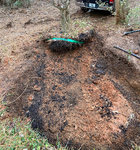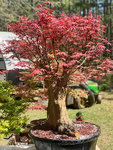FoldedFrog
Mame
I was fortunate enough to have a nice big Japanese Maple that grew to block my wife's view from one of the family room windows. One day she casually mentioned that she wished that tree weren't in the way and I instantly went to work!
The tree was originally between 20 and 25 feet tall so I promptly did a trunk chop in the early spring of 2015 (I think). I then performed a Dan Robinson removal by first trenching around one side of the tree in 2018 and refilling with some nice bonsai soil. In 2019 I trenched around the other side finishing it up in the same manner.
Two weeks ago I took on the task of removing the tree from the ground. Now, this tree's nebari is about 18 across and the trunk is around 8" in diameter. Needless to say I wasn't keen on the idea of digging under this root ball - I don't like digging at all, regardless of the size of the hole. Fortunately, the tree was on a hill with a steep side to it. I had the idea of removing the aforementioned fill soil and running a cable, looped around the bottom-most depth of the original trenches, and cutting the root ball free with one mighty tug from my Dodge (I call the Black Billy Goat). After two trips to the HD, I finally purchased a cable thick enough to do the trick and the tree was cut cleanly from the ground! I can't even imagine how much time I saved.
At any rate, I was left with a massive hole six feet in diameter and spent a full day working the root ball down to a manageable size. I worked it into a 24" livestock watering bowl I acquired from Tractor Supply and, needless to say, modified it for drainage. Below are a few photos commemorating the operation. The latest photos were taken today. I figure another 5 to 10 years of refinement and it should turn out pretty well.
.





The tree was originally between 20 and 25 feet tall so I promptly did a trunk chop in the early spring of 2015 (I think). I then performed a Dan Robinson removal by first trenching around one side of the tree in 2018 and refilling with some nice bonsai soil. In 2019 I trenched around the other side finishing it up in the same manner.
Two weeks ago I took on the task of removing the tree from the ground. Now, this tree's nebari is about 18 across and the trunk is around 8" in diameter. Needless to say I wasn't keen on the idea of digging under this root ball - I don't like digging at all, regardless of the size of the hole. Fortunately, the tree was on a hill with a steep side to it. I had the idea of removing the aforementioned fill soil and running a cable, looped around the bottom-most depth of the original trenches, and cutting the root ball free with one mighty tug from my Dodge (I call the Black Billy Goat). After two trips to the HD, I finally purchased a cable thick enough to do the trick and the tree was cut cleanly from the ground! I can't even imagine how much time I saved.
At any rate, I was left with a massive hole six feet in diameter and spent a full day working the root ball down to a manageable size. I worked it into a 24" livestock watering bowl I acquired from Tractor Supply and, needless to say, modified it for drainage. Below are a few photos commemorating the operation. The latest photos were taken today. I figure another 5 to 10 years of refinement and it should turn out pretty well.
.









